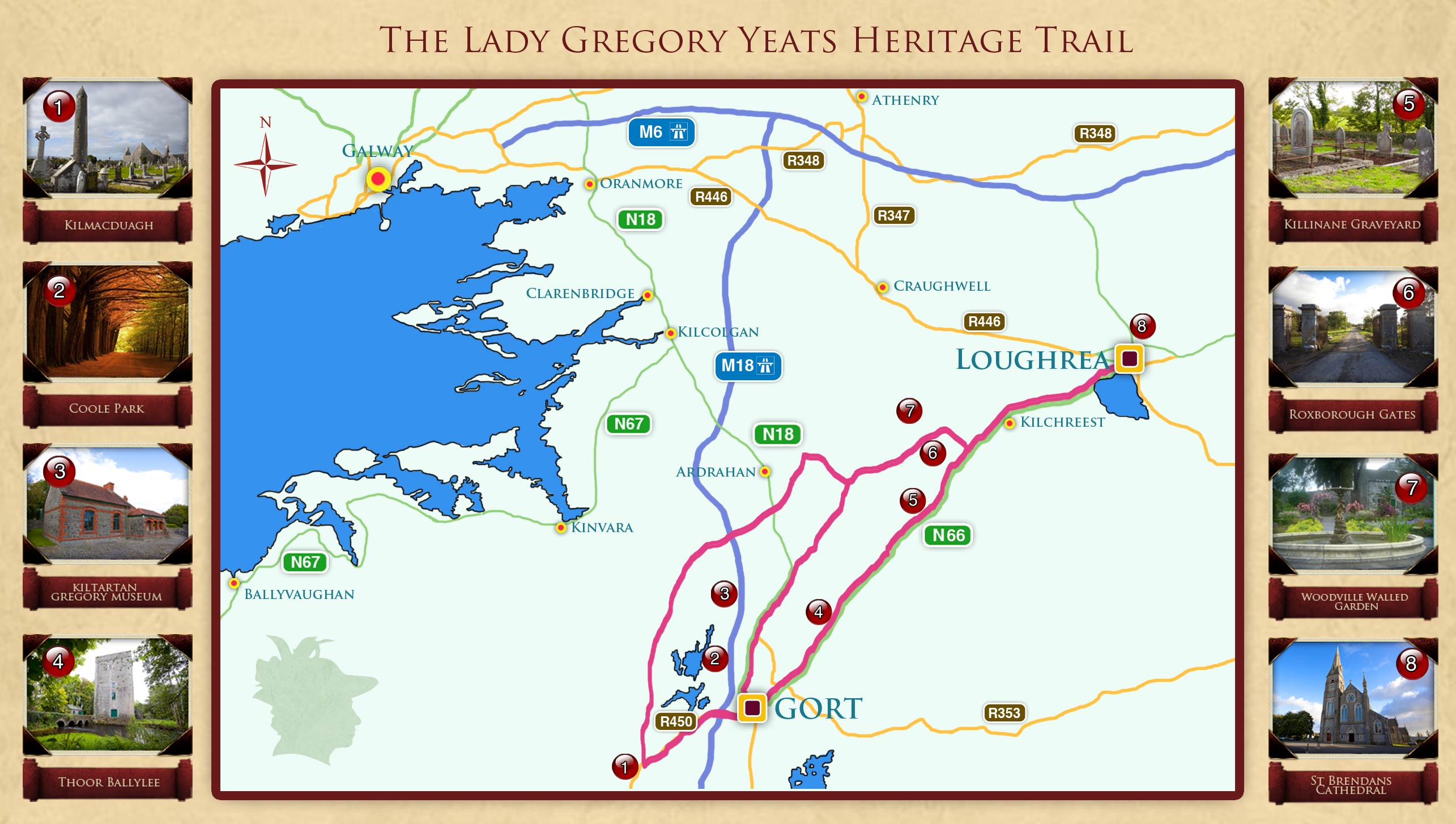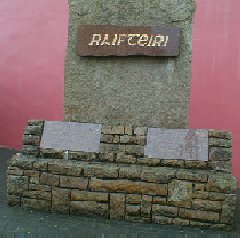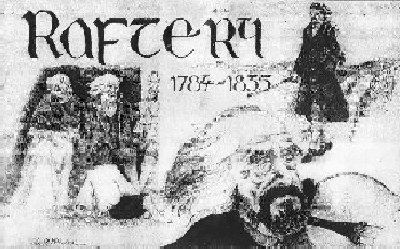Antoine Ó Raifteirí (perhaps better known as Blind Raftery) is an ancestor of mine, and a rather famous poet (1779–1835). He was blind as a result of having smallpox as a child. Consequently he did not write his poems or songs but committed them to memory. Moreover, he composed in Irish and there was no interest in publishing the work of an Irish minstral in Irish during his lifetime. Fortunately, others did capture his songs and poems on paper (at least some times) and some survived in the memories of other for decades. during the revival of Irish culture that took place a century after he lived, Douglas Hyde (Songs Ascribed to Raftery), Lady Gregory (Lady Gregory: Selected Writings) and William Butler Yeats hunted through the west of Ireland, discovering Raftery's songs and poems.
While Yeats is probably the more famous in the USA today, having won the Nobel Prize for Literature, Douglas Hyde was the first President of the Irish Free State. Lady Gregory was I suppose much more famous in her time than she is now, having published a number of books bringing the history of the Irish people to the attention of the Irish themselves. Yeats and Lady Gregory formed a long lasting literary partnership and friendship. Indeed, he bought a property, Thoor Ballylee (#4 on the map), just northeast of the town of Gort. Lady Gregory's home Coole Park is even closer to Gort, on the lake and just north west of Gort (#2 on the map) -- one could walk between the two. Clearly, proximity to his friend and colleague was important in the choice of location for Yeats' home in his later years Yet Lady Gregory had established Coole Park as a center for the intellectual elite and that too might have been important.
It also seems that the link of Blind Raftery, Mary Hynes and Thoor Ballylee may have been important in Yeats' choice of a home he would buy: from 1921 to 1929, Yeats with his family spent many summers there.
In his poem Coole Park And Ballylee, 1931 he wrote:
T
The interest of so many distinguished Irish intellectuals has generated modern events:
 |
| Thoor Ballylee |
While Yeats is probably the more famous in the USA today, having won the Nobel Prize for Literature, Douglas Hyde was the first President of the Irish Free State. Lady Gregory was I suppose much more famous in her time than she is now, having published a number of books bringing the history of the Irish people to the attention of the Irish themselves. Yeats and Lady Gregory formed a long lasting literary partnership and friendship. Indeed, he bought a property, Thoor Ballylee (#4 on the map), just northeast of the town of Gort. Lady Gregory's home Coole Park is even closer to Gort, on the lake and just north west of Gort (#2 on the map) -- one could walk between the two. Clearly, proximity to his friend and colleague was important in the choice of location for Yeats' home in his later years Yet Lady Gregory had established Coole Park as a center for the intellectual elite and that too might have been important.
 |
| Lady Augusta Gregory |
Under Gregory’s watchful eye Coole House had become a centre for literary and political gatherings, welcoming a great number of notable figures of the day, including William Butler Yeats, his brother the painter Jack Yeats, George Bernard Shaw, John Millington Synge, George Russell (A.E.), and the first President of Ireland, Douglas Hyde. Together with Edward Martyn, who lived down the road at Tulira Castle, Yeats and Gregory founded the Irish Literary Theatre, soon to become the Abbey Theatre. Yeats described the tower and surrounding landscape in his book The Celtic Twilight (1893), which featured local stories about the area and a poem by Antoine O Raifteiri (known to Yeats as Raftery, the poem translated by Lady Gregory) concerning his love for a local beauty named Mary Hynes.
 |
| Source: The Lady Gregory Yeats Heritage Trail |
 |
| Phoroggaph of William Butler Yeats by Alice Broughton. Platinum print. |
In his poem Coole Park And Ballylee, 1931 he wrote:
Under my window-ledge the waters race,And in The Winding Stair. Yeats wrote:
Otters below and moor-hens on the top,
Run for a mile undimmed in Heaven's face
Then darkening through 'dark' Raftery's 'cellar' drop,
Run underground, rise in a rocky place
In Coole demesne, and there to finish up
Spread to a lake and drop into a hole.
What's water but the generated soul?
I am content to live it all again And yet again, if it be life to pitch Into the frog-spawn of a blind man's ditch, A blind man battering blind men; Or into that most fecund ditch of all, The folly that man does Or must suffer, if he woos A proud woman not kindred of his soul.Raftery's Mary Hynes
James Stephens published a book of his versions of some of Raftery's poems in the 1920s. (Reincarnations by James Stephens (1882–1950). His text for three poems that combine into the choral piece by Samuel Barber, Reincarnations.
Mary Hynes
She is the sky of the sun,
She is the dart
Of love,
She is the love of my heart,
She is a rune,
She is above
The women of the race of Eve
As the sun is above the moon.
Lovely and airy the view from the hill
That looks down Ballylea;
But no good sight is good until
By great good luck you see
The Blossom of the Branches walking towards you
Airily.
Anthony O’Daly
Since your limbs were laid outAnd:
The stars do not shine,
The fish leap not out
In the waves.
On our meadows the dew
Does not fall in the morn,
For O’Daly is dead:
Not a flower can be born,
Not a word can be said,
Not a tree have a leaf;
Anthony, after you
There is nothing to do,
There is nothing but grief.
The Coolin
And here is Reincarnations (Samuel Barber) sung by the Cardinal Singers
Come with me, under my coat,
And we will drink our fill
Of the milk of the white goat,
Or wine if it be thy will;
And we will talk until
Talk is a trouble, too,
Out on the side of the hill,
And nothing is left to do,
But an eye to look into an eye
And a hand in a hand to slip,
And a sigh to answer a sigh,
And a lip to find out a lip:
What if the night be black
And the air on the mountain chill,
Where the goat lies down in her track
And all but the fern is still!
Stay with me, under my coat,
And we will drink our fill
Of the milk of the white goat
Out on the side of the hill.
T
The interest of so many distinguished Irish intellectuals has generated modern events:
A drawing believed to be of Raftery
An annual festival, Féile Raiftéirí, is held in Loughrea, Co. Galway each year on the last weekend in March. Raftery spent most of his later years in townlands close to the town. The festival features a contemporary Irish language poet and promotes the native arts of Ireland. The festival ends with a visit to Raiftéirí grave in neighbouring Craughwell.
Ó Raifteirí died at the house of Diarmuid Cloonan of Killeeneen, near Craughwell, County Galway, and was buried in nearby Killeeneen Cemetery. In 1900, Lady Gregory, Edward Martyn, and W.B. Yeats erected a memorial stone over his grave, bearing the inscription "RAFTERY". A statue of him stands in the village green, Craughwell, opposite Cawley's pub. (Source)
 |
| Kiltmagh granate memorial |
Kiltimagh (where Raftery was born) town square features a granite memorial in honour of Anthony Raftery erected in 1985, in that same year Kiltimagh twinned with Craughwell, the final resting place of the blind Gaelic poet. (Source)



